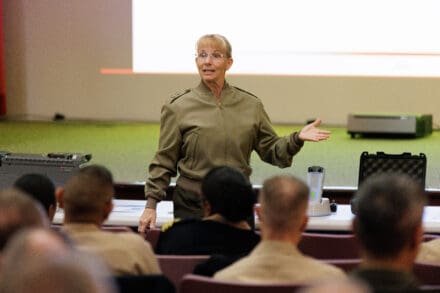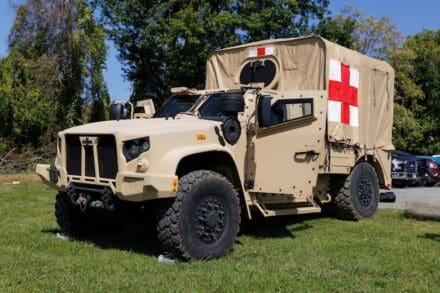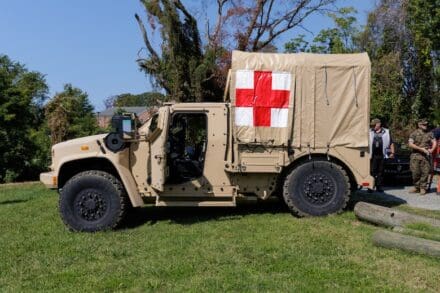Marine Corps Base Quantico, Va. —
Because the world enters an period of renewed nice energy competitors, the Marine Corps is quickly modernizing to fulfill the challenges of the fashionable battlefield.
Envisioning a return to contested littorals, Marine Corps Programs Command’s PM Fight Assist Programs is fielding cutting-edge expeditionary medical capabilities designed to extend warfighter survivability behind enemy strains. Guided by Drive Design, the Expeditionary Medical Programs workforce is quickly deploying these superior medical capabilities to make sure Marines are ready for the long run combat.

In response to Navy CAPT Janine Espinal, EMS workforce lead and senior medical logistician: “These capabilities not solely guarantee we will maintain operations by offering life-saving care beneath hearth, but additionally improve survivability in Expeditionary Superior Base Operations (EABO) environments, the place speedy, adaptive medical assist is important to preserving Marines within the combat.”
Medication Beneath Fireplace: A Battlefield Perspective
To check these capabilities in motion, contemplate this hypothetical state of affairs the place Marines depend on expeditionary medical programs in a contested battlespace. The next state of affairs report demonstrates how these instruments could be employed behind enemy strains.
State of affairs Report
Location: Undisclosed, first island chain, INDOPACOM
Date: November 10, 20XX
Time: 1300 Hours
Within the oppressive humidity of the Indo-Pacific’s contested littorals, a Marine platoon holds a important place on a distant, undisclosed island—removed from resupply or reinforcements. Whereas the jungle gives pure cowl, their superior uniforms render them invisible, hidden from infrared and electromagnetic detection. To enemy sensors, they’re phantoms—the ghosts of Satan Canines previous, returning to the theater the place legends like GySgt John Basilone and LtGen “Chesty” Puller carved their legacy in blood and hearth.
At a distant Expeditionary Superior Base, a younger Lance Corporal leans in opposition to a Joint Gentle Tactical Car (JLTV), having fun with his favourite MRE. On this unforgiving battlespace, the chili mac is value its weight in gold. Hid by cutting-edge camouflage netting, the car blends into the jungle, nearly invisible due to multi-spectral safety. Its rugged design powers by means of robust terrain, whereas the CASEVAC package ensures it may be quickly reconfigured to evacuate injured Marines from the entrance strains.
Because the Marines advance by means of the dense jungle, they immediately come beneath intense enemy hearth. One Marine is wounded, requiring a right away casualty evacuation to save lots of his life. His squad lays down a heavy base of fireside, enabling the car to interrupt contact and rush him to a hid medical station. A Navy Corpsman, geared up with Harm Management Resuscitation (DCR) and Surgical procedure (DCS) programs, shortly stabilizes the Marine. Transportable refrigeration models hold life-saving blood on-site, guaranteeing important care regardless of the space from the ambush. Deep behind enemy strains, these expeditionary capabilities are a lifeline, enabling warfighters to outlive and convey the combat tonight.
Though fictional, the state of affairs described is a detailed reflection of what our Marines are making ready to face on the long run battlefield. To combat and win throughout the globe’s contested littorals, Marines want speedy, adaptive medical capabilities that improve survivability when evacuation isn’t an possibility.
As famous by CMDR David Gribben, department head for the Naval Assist Department at CD&I, “Our focus should be to make sure that our logistics method is completely aligned with the Marines. As they get lighter and extra agile, we’re doing the identical with our medical capabilities. We’re matching their mobility with gentle, moveable programs—shelter, communications, medical tools—that combine seamlessly with the Marine Corps’ logistics framework. This interoperability permits us to quickly deploy and assist Marines in contested environments, giving them the perfect likelihood of survival in essentially the most austere situations.”
Fielding Expeditionary Survivability
To handle these challenges head-on, PM CSS’s Expeditionary Medical Programs Group lately hosted the Well being Providers Operational Advisory Group (HSOAG) at Marine Corps Base Quantico, Va., bringing collectively senior medical leaders from Okinawa, Hawaii, Germany and numerous CONUS and OCONUS areas. Over 4 days, Marines, greenside Navy medical personnel, and civilian acquisition professionals evaluated healthcare programs and constructions, specializing in evolving capabilities to fulfill Drive Design necessities.

Throughout the HSOAG assembly, standing earlier than a JLTV fitted with the newest CASEVAC package, Rear Adm. Pamela Miller, Medical Officer of the Marine Corps, highlighted the important significance expeditionary medical capabilities in twenty first century warfare.
She famous: “The event of our medical capabilities is essential as a result of we have to keep related, making ready for future conflicts quite than the final. We’re dealing with new challenges not seen since World Battle II, and there’s urgency to adapt to fulfill the Commandant’s directive, Drive Design, and work with the naval enterprise by means of Distributed Maritime Operations. With Fleet Well being Providers and Bureau of Medication and Surgical procedure management right here, we’re aligning our focus to make sure we will assist the warfighters within the subsequent combat.”

All through the week, a number of key medical capabilities have been highlighted, beginning with the JLTV CASEVAC Equipment, an important modification to the JLTV Utility variant. This method permits for the speedy transport of two litters and a bounce seat within the cargo mattress, enhancing casualty evacuation in austere, contested environments. Its adaptability helps operational flexibility on the battlefield, as emphasised by Rear Adm. Miller, who famous its very important position in boosting casualty evacuation capabilities and sustaining drive lethality. In response to Capt. James Minturn, JLTV mission officer at PEO Land Programs, the flexibleness offered by the CASEVAC package is a key benefit in contested environments.
In his phrases: “The JLTV provides commanders choices. They will use it for troop transport one second, then shortly change to casualty evacuation when wanted. As a substitute of dedicating a car solely to medical transport, the CASEVAC package lets models adapt on the fly, which is important in environments the place car motion is restricted. It’s all about maximizing functionality with out overcommitting assets.”
The Expeditionary Transportable Oxygen Era System (EPOGS) was one other standout, providing a light-weight, cellular answer for delivering medical-grade oxygen. EPOGS improves reliability, mobility, and ease of transport, making it important for forward-deployed operations in difficult environments.
Moreover, the Expeditionary Medical Refrigeration Unit (EMRU) gives prolonged cooling for important medical provides similar to blood, vaccines, and drugs, sustaining temperatures for over three days with out exterior energy. This functionality considerably outpaces older programs, which had an eight-hour limitation.
Lastly, the Harm Management Resuscitation (DCR) and Harm Management Surgical procedure (DCS) programs have been highlighted for his or her compact, modular designs, enabling life-saving trauma care close to the entrance strains in contested environments. These scalable programs guarantee important care reaches Marines even when evacuation is delayed, aligning with the Corps’ concentrate on distributed operations and survivability behind enemy strains.
Anticipating the Future Struggle
Within the race to 2027, PM CSS’s Expeditionary Medical Programs workforce is advancing important capabilities that improve battlefield survivability for the Marine Corps, the Joint Drive, and our worldwide companions. Programs just like the JLTV CASEVAC Equipment, superior refrigeration, and moveable oxygen era are important for delivering well timed medical assist in contested environments. These improvements, backed by speedy acquisition processes, guarantee operational readiness in essentially the most difficult situations.
Examined in workout routines like World Medic 2024 and confirmed in real-world conflictssuch as Russia’s invasion of Ukraine, these expeditionary medical capabilities are important for the long run combat. Cellular medical models, injury management surgical procedure, and forward-positioned resuscitative care have demonstrated their means to cut back preventable deaths and preserve drive lethality beneath hearth. As these capabilities proceed to evolve, they may stay important in guaranteeing speedy response and flexibility in contested environments. By prioritizing joint collaboration and acquisition pace, PM CSS’ EMS workforce is setting the usual for medical readiness and guaranteeing our warfighters are geared up for fulfillment in an ever-evolving battlespace.
By Johannes Schmidt, MCSC Workplace of Public Affairs and Communication, Marine Corps Programs Command
Images by Jim Van Meer
You possibly can skip to the tip and depart a response. Pinging is presently not allowed.



